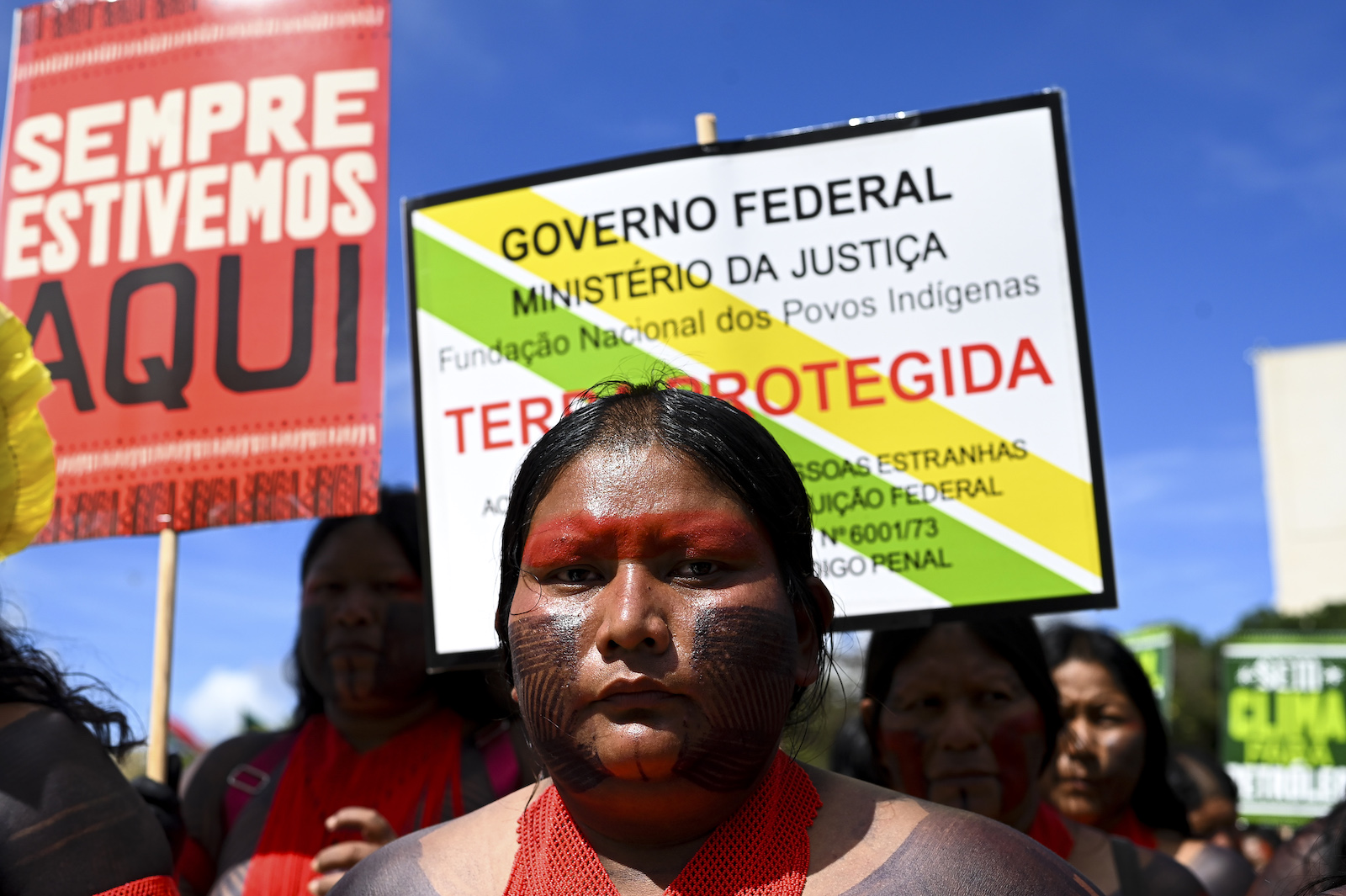When Indigenous community organizer Jade Begay, Tesuque Pueblo and Diné, found out that Donald Trump had won the election in November 2016, she was en route to Standing Rock from New Mexico to protest the Dakota Access pipeline.
The underground oil pipeline snaking from North Dakota to Illinois had been the target of years of opposition by Indigenous activists like Begay, who had filed lawsuits against the pipeline and then withstood freezing temperatures and armed police to block its construction after their legal challenges failed.
The strength of their resistance had turned Standing Rock into an international symbol of Indigenous activism and resistance. It had inspired a new generation of Native American activists, and helped lead to a 2016 victory by the U.S. Army Corps of Engineers in the waning months of the Obama administration to delay the opening of the pipeline.
But the moment Begay learned of Trump’s victory, sitting in a ramen shop in Colorado on her way north from New Mexico, she realized that win would be short-lived.
She was right. On January 24, 2017, just four days after his presidential inauguration, Donald Trump signed an executive order to speed up the construction of the Dakota Access pipeline and pave the way for the 1,172-mile pipeline to go online just five months later. The decision set the tone for the Republican presidency: Again and again, Indigenous peoples found themselves scrambling to block decisions by the Trump administration that upended decisions that had been made under Obama’s.
Native peoples achieved a few scattered wins: The Trump administration recognized seven tribes, repatriated Indigenous ancestral remains from Finland, and established a task force on missing and murdered Indigenous people. But his administration’s record on land and the environment was one in which Indigenous activists were often on the defense.
Trump rolled back the Bears Ears Monument by 85 percent to open up the area for drilling, prompting lawsuits from Indigenous-led groups. He pushed forward the Keystone XL pipeline, again ignoring Native opposition. He sought to open up parts of the Arctic National Wildlife Refuge for drilling despite opposition from Indigenous groups such as the Gwich’in Steering Committee and Cultural Survival.
His border wall construction in Guadalupe Canyon, Arizona, harmed the Tohono O’odham Nation’s 10,000-year-old sacred burial ground. His administration sought to remove land from the Mashpee Wampanoag Tribe in New England, the first such move in several decades since the Termination Era during which the federal government sought to remove tribal lands and status.
“Working to protect tribal communities or Indigenous communities during the Trump administration was extremely difficult because the attacks were continuous,” Begay said.
Now that Trump is vying for a second term, this time with Ohio Senator J.D. Vance at his side, Native Americans who experienced his first presidency say they expect that a second one would mean more support for fossil fuel projects on reservations.
That might be good news for the small fraction of the more than 500 federally recognized tribes in the U.S. who choose to allow fossil fuel extraction on their lands. Daniel Cardenas from the National Tribal Energy Association said he appreciated the Trump administration’s support for tribes that wanted to pursue oil and gas production, and thought the Biden-Harris administration was too singularly focused on green energy.
But Indigenous environmental advocates, like Gussie Lord, a citizen of Oneida Nation and managing attorney of the Tribal Partnerships Program at Earthjustice, felt like they were overwhelmed during the Trump administration as they watched environmental regulations and commitments like the Paris Agreement fall one after the other. To Lord, Trump’s first term was packed with “real backwards-looking actions and a real backwards approach to tribal issues.”
In contrast, six days after taking office, President Joe Biden issued a memorandum requiring federal agencies to engage in meaningful consultation with tribal nations. Whereas Trump’s coronavirus relief funding initially delayed funding for tribes, the Biden-Harris administration incorporated them more fully into the creation of legislation and budgets, leading to a 50 percent increase in funding for tribal nations compared with the previous four years under Trump.
“The last four-year period was the most constructive in American history as it relates to the relationship between Native people and the United States government,” said Brian Schatz, the head of the Senate Committee on Indian Affairs, who helped usher the funding through Congress.
Larry Wright, the head of the National Congress of American Indians, hopes that whoever is elected in November continues some of the progress for Indian Country made under the Biden-Harris administration, such as incorporating Indigenous knowledge into environmental reviews; proactively advancing co-stewardship; and setting aside funding for tribes facing forced relocation due to climate change.
Trump hasn’t talked a lot about what specifically he’d do regarding tribes in his next presidency. A spokesperson for his campaign didn’t respond to a request for comment. The 16-page summary of the Republican platform on Trump’s campaign website doesn’t include the words “tribe,” “Native,” or “Indigenous.” But it does lay out unambiguously how Trump stands on energy projects.
“Common Sense tells us clearly that we must unleash American Energy if we want to destroy Inflation and rapidly bring down prices, build the Greatest Economy in History, revive our Defense Industrial Base, fuel Emerging Industries, and establish the United States as the Manufacturing Superpower of the World,” the platform says, capitalization included. “We will DRILL, BABY, DRILL and we will become Energy Independent, and even Dominant again.”
That commitment to fossil fuel production is sure to deepen the climate crisis, harming Indigenous peoples who are disproportionately likely to experience negative effects of climate change. Tribes living on reservations in the U.S. are more susceptible to heat waves, wildfires, and droughts than they would’ve been if they’d been allowed to remain on original lands.
Yet despite the Biden-Harris administration’s climate justice rhetoric, it has pursued fossil fuel production even more successfully than Trump’s did, and oil and gas production has reached record highs.
Many Native Americans feel disillusioned by both parties. “It doesn’t matter who is president, if it’s a D or an R, they’re not our friends,” Cardenas said.
The Biden-Harris administration has also supported extractive renewable energy projects opposed by Indigenous peoples, providing a $2 billion loan for a lithium mine at Thacker Pass, Nevada, that’s opposed by multiple tribal nations.
“There’s been a huge push for domestic sources of critical minerals, which was something that started under the Trump administration but has continued under the Biden administration, and the Biden administration has put a lot of money into it,” Lord from Earthjustice said, adding that that’s a concern given the proximity of such minerals to Native lands.
The vast majority of minerals that are key to the energy transition are found within 35 miles of federal reservation land, which means they’re likely to be on ancestral lands taken from Native peoples.
Still, Lord said she’s been happy with the Biden-Harris administration’s efforts to incorporate tribal perspectives in their decision-making compared with the lack of input tribes had under the first Trump administration.
Schatz from the Senate Indian Affairs Committee thinks that voters don’t have the luxury to vote third-party if they care about Native peoples.
“The difference is stark: One party wants to restore and cultivate self-determination, wants to provide resources for housing and education and health care and natural resource management. And the other party wants to, at best, ignore the tribes, and in many instances, through their right-wing legal machine, do violence to the very foundation of tribal sovereignty,” he said.
Wright from the National Congress of American Indians said he understands why some tribal citizens might feel disillusioned. He suggests that rather than voting by party or abstaining from voting, tribal citizens create a “sovereignty ticket” to support whichever candidates are more supportive of tribes.
“Bad people get elected by Native people who don’t vote,” he said.
Editor’s note: Earthjustice is an advertiser with Grist. Advertisers have no role in Grist’s editorial decisions.
This story was originally published by Grist with the headline What a second Trump presidency could mean for Indigenous peoples on Oct 3, 2024.
Under the Biden-Harris administration, tribes got more of a say in Congress and tons more funding. A Trump-Vance win could upend that. Elections, Indigenous Affairs, Politics Grist






